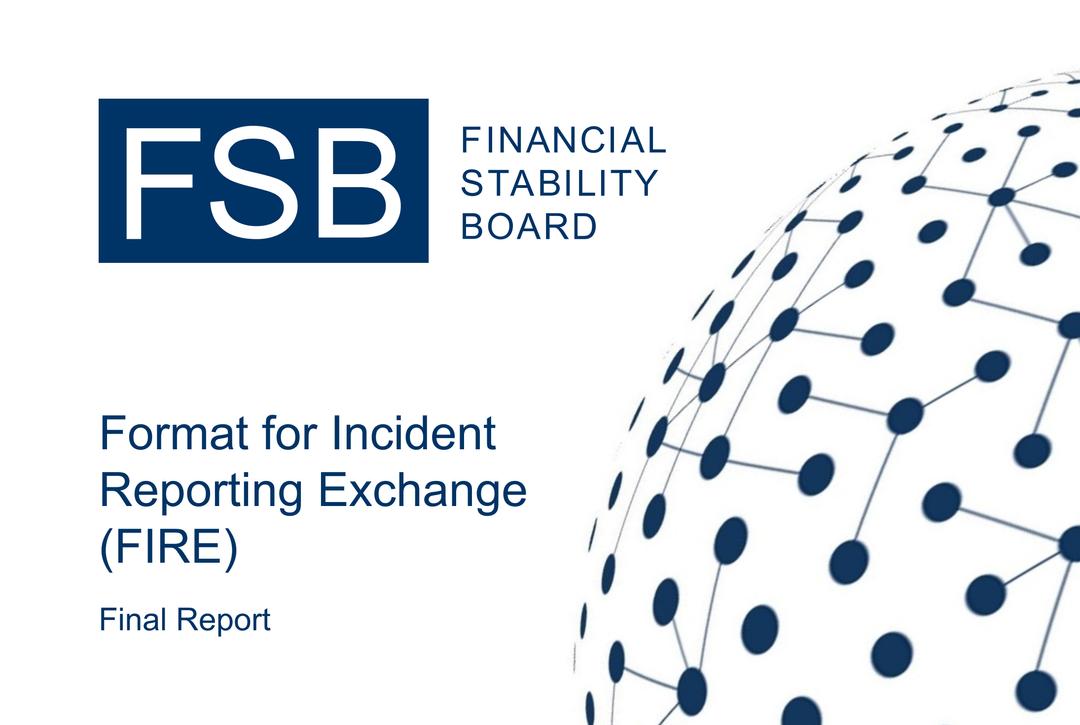




Eric DeGrass
May 14th, 2025
Introduction to the FSB and FIRE
The Financial Stability Board (FSB) coordinates internationally among national financial authorities and standard-setting bodies to ensure global financial stability. Its policies, though non-binding, strongly influence global financial practices. Recently, the FSB published a significant milestone: the Format for Incident Reporting Exchange (FIRE), aiming to standardize the way financial institutions report operational incidents globally.
Read the official announcement here. Download the full report (FIRE) here.
Understanding FIRE’s Objectives and Structure
FIRE addresses the fragmented and inconsistent incident reporting practices that challenge institutions operating across multiple jurisdictions. It promotes harmonization to support rapid response and effective incident management through clearly defined structured reports and machine-readable formats (FIRE, p. 6-8).
Specifically, FIRE emphasizes:
Structured reporting with clear fields and enumerations (Annexes C to O, p. 52-67).
Machine-readable data exchange leveraging Data Point Model (DPM) and XBRL taxonomy (Structured data model, p. 6-7).
Comprehensive categorization of operational incidents, including cyber and non-cyber events (Scope of FIRE, p. 3-4).
Where FIRE Excels: An Emphasis on Broad Operational Incident Reporting
FIRE explicitly supports comprehensive operational incident reporting beyond just cyber incidents. The document classifies incidents broadly, including Business Disruption, System, or Execution Failures explicitly covering non-cyber incidents such as third-party vendor bugs (Annex C, p. 52). Moreover, FIRE clearly acknowledges third-party relationships in operational disruptions, capturing impact to vendors and supply chains (Section 3.2, Affected Parties, p. 31-32).
Identifying FIRE’s Gaps: Where non-Cyber Vendor Bugs Need More Attention
However, FIRE might be seen as having notable gaps regarding third-party non-cyber vendor bugs:
Limited Granularity for Vendor-Caused Incidents: FIRE’s broad categories, such as "Information System Failures" (Annex N, p. 64-66), do not sufficiently distinguish vendor software quality issues, potentially obscuring the root causes of operational disruptions.
Absence of Dedicated Reporting Triggers for Vendor Issues: Incident reporting triggers in FIRE (Section 2.2, Incident reporting trigger, p. 24-26) lack explicit criteria tied specifically to third-party software quality and updates, making proactive management of vendor-related disruptions more challenging.
Insufficient Guidance on Vendor Accountability and Follow-up: FIRE’s "lessons identified" approach (Section 4.2, Lessons, p. 43-44) lacks clear mechanisms for tracking vendor remediation efforts and accountability, potentially allowing recurring vendor-caused issues without robust improvement processes.
How BugZero Supports FIRE Compliance and Addresses Vendor Bug Reporting Gaps
BugZero uniquely positions itself to not only fully align with FIRE’s structured reporting guidance but also addresses critical gaps in reporting third-party non-cyber vendor software issues:
1. Structured and Machine-Readable Incident Reporting:
BugZero can be configured to align with FIRE’s reporting fields and classifications, fully integrating enumerations and structured data requirements (Annexes C-O, p. 52-67).
2. Detailed Vendor and Third-party Reporting:
Explicit identification and granular classification of vendor-related incidents provide clarity beyond FIRE’s current broad definitions, clearly distinguishing vendor-originated software bugs.
Advanced reporting triggers explicitly tailored to proactively address vendor software quality issues, exceeding FIRE’s generic triggers (p. 24-26).
3. Vendor Accountability and Comprehensive Follow-up Tracking:
Comprehensive tracking capabilities for vendor accountability, remediation plans, and follow-ups clearly address FIRE’s limited guidance (p. 43-44).
Dashboards and status reports dynamically monitor vendor remediation efforts, enhancing transparency and operational resilience.
Unique Capabilities Enhancing Operational Resilience
BugZero further strengthens financial institutions’ operational resilience with unique features:
Single Source of Truth: Centralizes and manages third-party operational bug data securely, reducing data fragmentation and compliance complexity.
Seamless ServiceNow Integration: Automates incident creation, management, and reporting directly through ITSM platforms like ServiceNow, providing efficient closed-loop incident management.
Automated Risk Detection and Assessment: Real-time monitoring and automated risk assessments that can be aligned with FIRE’s recommended severity scales (Annex E, p. 54), offering proactive risk management.
Importance and Implications for Financial Institutions
As financial institutions increasingly rely on third-party software and services, explicitly addressing vendor-related operational risks becomes essential. Institutions adopting FIRE’s new standard should be mindful of these gaps to ensure comprehensive reporting and effective risk mitigation.
FIRE marks a transformative shift in global incident reporting standards. However, financial institutions must address the highlighted gaps, especially around non-cyber vendor software bugs. Leveraging solutions like BugZero can significantly enhance the effectiveness and comprehensiveness of operational incident management.
Ready to enhance your institution’s operational resilience?
Contact BugZero today to learn how our platform supports your journey to comprehensive FIRE compliance and robust third-party risk management.


Eric DeGrass
October 21st, 2025


Eric DeGrass
September 24th, 2025
Sign up to receive a monthly email with stories and guidance on getting proactive with vendor risk
BugZero requires your corporate email address to provide you with updates and insights about the BugZero solution, Operational Defect Database (ODD), and other IT Operational Resilience matters. As fellow IT people, we hate spam too. We prioritize the security of your personal information and will only reach out only once a month with pertinent and valuable content.
You may unsubscribe from these communications at anytime. For information on how to unsubscribe, as well as our privacy practices and commitment to protecting your privacy, check out our Privacy Policy.


Eric DeGrass
October 16th, 2025